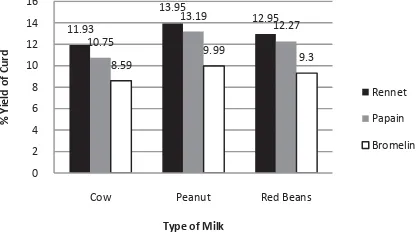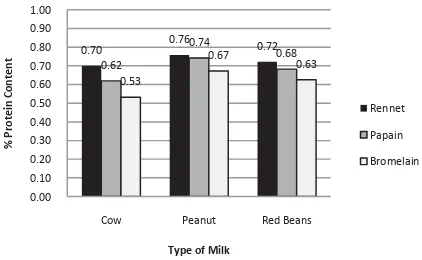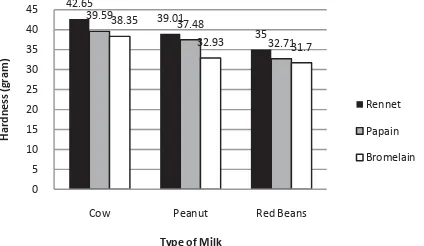The Effects of Milk Types (Cow, Peanut, Red
Bean) And Enzyme Types (Rennet, Papain,
Bromelain) Towards The Quantity And
Quality of Cheddar Cheese
Ariestya Arlene, Anastasia Prima Kristijanti, Adelia Phani
Department of Chemical Engineering, Industrial Technology Faculty
Parahyangan Catholic University, Bandung, West Java, Indonesia
[email protected]
Abstract
—
Cheddar cheese is one kind of dairy products with a high demand in Indonesia, where the common raw material, the cow milk is produced. Unfortunately, few consumers are lactose intolerant. For them, cow milk can be substituted with other milk which does not contain lactose, such as milk made from peanut or red beans. The commonly used enzyme in processing the cheddar cheese is Rennet, but other enzyme can also be used, such as Papain enzyme from papaya fruit and bromelain enzyme from pineapple. These substitute enzymes are obtained from local fruit which is potential to change the rennet. The purpose of this research is to study the effects of variation of milk as the raw materials and enzymes coagulant toward the yield of cheddar cheese and its qualities (water content, ash content, protein content, fat content, calcium content, and texture). The method of this research comprises preliminary experiments, a main experiment, and analyses. Preliminary experiments consist of manufacture and pasteurization of peanut and red bean milk, and the analysis of the enzyme activity. The main experiment consists of the production of cheddar cheese with cow milk, red bean milk, and peanut milk as the raw material. Analyses conducted are analysis of water, ash, protein, fat, calcium, and texture of the cheese. The highest yield of the cheddar cheese is 13,95%, obtained from the cheese made of peanut milk and Rennet enzyme.Key words – cheddar, cheese, rennet, papain, bromelain
I. INTRODUCTION
The cheddar cheese is the cheese with pale yellow or ivory white color, strong flavor and compact texture [14]. This cheese comes from Cheddar village, Somerset, England and become the most popular cheese in England. The cheddar cheese is also produced in United States of America, Iceland, and other countries including Indonesia [8].
The main ingredient to make cheddar cheese is milk. The cow milk is commonly used to make cheese. However, the cow milk has high fat content and can
cause the cholesterol formation in the human body. Also, some cheese consumers suffer the lactose intolerance, which they cannot digest the lactose contained in the cow milk [17]. Therefore, the vegetable milk from red bean and peanut is potential to replace the cow milk. The main requirement of milk in the cheese production is the high protein content, since the cheese is formed from the coagulation from milk protein [5].
The milk coagulation process can be occurred by conditioning the milk in an acid environment with the addition of enzyme. The most common enzyme is rennet which is the protease enzyme derived from cow abomasums. Since rennet is limited and quite expensive, the other protease enzymes which can be used are papain and bromelain enzymes [10]. The papain enzyme comes from papaya which is easily found in Indonesia. The bromelain enzyme is made from pineapple with high production level in Indonesia [3].
The purpose of this research is to analyze the effects of milk and enzyme types on the quantity and quality (water content, ash content, protein content, fat content, calcium content, and texture) of cheddar cheese and the interaction of enzyme and milk types on the quantity and quality of cheddar cheese.
II. RESEARCH METHODOLOGY
A. Material
The ingredients in this research were three types of milks, three types of enzymes, and one starter. The cow milk bought from Setiabudi Supermarket, Bandung, the red bean milk and peanut milk were made of the red bean and peanut which is bought from Kanoman traditional market, Cirebon.
enzyme made of pineapple bought from Setiabudi Street, Bandung. The starter is Lactobacillus lactis from Trie's Cheese, Depok.
B. The Milk Pasteurization
The milk was heated in a temperature of 62.8°C for 30 minutes. The milk was then cooled until the temperature became 40°C.
C. The Production of Red Bean Milk
One kg of red bean was soaked for 8 hours, added with water with the mass ratio of water : red bean is 1 : 0.8, blended, and heated for 20-30 minutes at 80oC. After the boiling process, the red bean milk was filtered. D. The Production of Peanut Milk
One kg of peanut was cleaned then heated in 12 liter of water at 70oC for 2 minutes and peeled.11 liter of water was added and the mixture was blended and filtered.
E. The Bromelain Isolation
The pineapple was cut into small pieces then it was homogenized with phosphate buffer solution of pH 7.5 with the mass ratio 1:1. The solution was centrifuged with the Hittech centrifuge on 3,000 rpm for 15 minutes. The supernatant is the rough extract of bromelain enzyme.
F. The Analysis of Enzyme Activeness
100 ml of milk was dissolved with 0.05 M CaCl2.2H2O, and incubated for 30 minutes at 40oC. 1 ml
(or 1 mg) of enzyme was added and stirred until coagulation was occurred. The coagulation time was recorded.
G. The Production of Cheese
CaCl2 with the percentage 0.2% (b/v) was added
to the pasteurized milk and cooled until the temperature reached 37oC. The starter was added as much as the weight of milk, then the mixture was allowed to coagulate for 30 minutes. After being coagulated, the enzyme was added and incubated for 30 minutes until the curd was formed. The curd was cut with a size of 3 cm x 3 cm and left for 10 minutes. The mixture is heated slowly to 380C temperature (the rising of the temperature is 2oC in 5 minutes) and then filtered.The curd was put in a container and pressed with the pressure 1.4 atm for 2 hours at room temperature. The pressed curd was then ripeness at a refrigerator for 90 minutes. This process is called cheddaring. The cheese was pressed again with the pressure 1.4 atm for 24 hours at room temperature. The pressed curd was then immersed in candle liquid and ripeness at a refrigerator for 1 month.The cheese is formed after this process.
H. Analysis
The analyses in this research consist of the analysis on content of water [1], ash [2], protein (the Kjeldahl method), fat (Babcock method), calcium (Murexide method), and hardness using texture analyzer instrument Brookfield CT 3 4500.
III. DISCUSSION
A. The Analysis of Enzyme Activeness
The enzymes have different activeness. The rennet enzyme has higher activeness than papain and bromelain enzymes since the optimal temperature of rennet enzyme is 40oC which is almost the same with the temperature of enzyme addition [6]. Meanwhile, the papain, and bromelain enzyme has the optimal temperature between 50-65oC and 55oC, respectively [7].
The enzyme has higher activeness in cow milk than red bean milk and peanut milk. This is because of the difference of chemical structure in the animal milk and vegetable milk. Kappa casein contains cystine while the amount of cystine from vegetable protein is lower than the animal protein. The cystine in animal protein is more active to coagulate the casein with the presence of the enzyme. The enzyme activeness analysis is shown in Figure 1.
Figure 1 Analysis of Enzyme Activeness
B. The Yield of Cheddar Cheese
The yield of curd from cow, peanut, and red bean milk are different on the same enzyme. The cheddar cheese from peanut milk results in the highest yield. The yield depends on the protein content. The peanut milk has the highest protein so thus it also results in the highest curd yield.
Figure 2 Yield of Curd
The yield of cheese made of rennet enzyme is the highest. The activity of rennet enzyme is higher than
0.32
Cow Peanut Red Beans
E
Cow Peanut Red Beans
the papain and bromelain enzymes, thus the more curd is formed. The yield of the curd is shown in Figure 2.
Based on the experimental design, it can be concluded that the types of milk and enzyme affect the yield of the curd and there is no interaction between the types of milk and enzyme on curd yield.
C. The Analysis of Water Content
The water content from cheese made of red bean and peanut milk are higher than the cow milk. This is because of the water content of red bean and peanut milk which are higher than the cow milk. Furthermore, the vegetable milk is hydrophilic. The peanut and red bean contain an amino acids with polar characteristic and easy to bind with water results in hydrophilic characteristic [16]. Meanwhile, the animal milk has the hydrophobic chains among the casein bonds. The presence of lactic acid affects the electrostatic load of casein which reduces the electrostatic power.
The water content of cheese made of bromelain and papain enzymes is higher than rennet enzyme. In the cheese production process, the rennet enzyme works more optimal since it approaches its optimal temperature, thus can results in lower water content cheese. The more optimal the enzyme performance is, the more perfect the coagulation process. The water content analysis is shown in Figure 3.
Figure 3Analysis of Water Content in Cheese
From the experimental design, it can be concluded that the types of milk and enzyme affects the water content of the cheese and there is no interaction between the types of milk and enzyme on the water content.
D. The Analysis of Ash Content
The ash content is affected by the raw material. The red bean milk has the highest ash content, thus the cheese made of red bean milk has the highest ash content.
The ash content in cheese made of rennet and papain enzymes tend to be higher than made of the bromelain enzyme. This is due to the phase of the rennet and papain in the form of solid and also the enzyme
dosage lower than bromelain enzymes. The ash content analysis is shown in Figure 4.
Figure 4 Analysis of Ash Content
Based on experimental design, it can be concluded that the types of milk and enzyme affects the ash content of the cheese and there is no interaction between the types of milk and enzyme on the ash content.
E. The Analysis of Protein Content
The cheese from peanut milk has highest protein content. This is because of the protein content of the raw material. The protein content of red bean and peanut milk is higher than the cow milk.
The cheese made of rennet enzyme has the highest protein content. This is because of the aspartate protease contained in the rennet enzyme. On the aspartate protease, the reaction of nucleophile acts as the catalyst happens simultaneously, thus it has shorter duration than the cysteine protease contained in papain and bromelain enzyme that works on two stages [12].
Figure 5 Analysis of Protein Content
Due to the faster mechanism, the curd will be more perfect to bind the protein and results in whey with lower protein content. The protein content analysis is shown in Figure 5.
From the experimental design, it can be concluded that the types of milk and enzyme affects the protein content of cheese and there is no interaction
38.5 40.5
Cow Peanut Red Beans
% M
Cow Peanut Red Beans
% As
Cow Peanut Red Beans
between the types of milk and enzyme on protein content of cheese.
F. The Analysis of Fat Content
The cheese made of peanut milk has the highest fat content since the fat content in the peanut milk is also highest. The cheese made of papain and bromelain enzymes has higher fat content than cheese with rennet enzyme. This is because the peanut milk has the almost same pH as the optimal pH from the lipase enzyme contained in the papain and bromelain enzyme. The pH of cow, peanut and red bean milk is 6.23, 6.01, 6.21, respectively. The optimal pH from papain and bromelain enzymes is 7-8 [13] while the rennet enzyme is 5.8 [18]. If the enzyme worked on the optimal pH, the ability of lipase enzyme to hydrolyze fat is better, and results in a lower fat content in the curd and a higher fat content in the whey. The fat content analysis is shown in Figure 6.
Figure 6 Analysis of Fat Content
Based on the result of the experimental design, it can be concluded that the types of milk and enzyme affects the fat content of cheese and there is no interaction between the types of milk and enzyme on the fat content of the cheese.
G. The Analysis of Calcium Content
The cheese made of cow milk has the highest calcium content. The raw material (cow milk) has the highest calcium content. The calcium content of cheese made of rennet enzyme is the highest. The cheese production process is conducted on the optimal condition of rennet enzyme. This condition makes the coagulation process occur better, thus can result in a lower water content and a higher calcium content [15]. The calcium content analysis is shown in Figure 7.
From the experimental design, it can be concluded that the types of milk and enzyme affects the calcium content of cheese and there is no interaction between the types of milk and enzyme on the calcium content.
Figure 7 Analysis of Calcium Content
H. The Texture Analysis
The cheese made of cow milk has the lowest water content, thus the hardness of the cheese is the highest. The water content of the cheddar cheese made of rennet enzyme has the lowest water content which makes the hardness of the cheese is the highest.
The difference of the cheese texture is caused by the calcium content of milk. The lower the calcium content, the easier the casein to move because of the decreasing interaction of the casein molecule. The easier the casein to move, the easier the cheese melts and the softer the texture will be [15].The ratio of cheese texture analysis is shown in Figure 8.
Based on the result of experimental design, it can be concluded that the types of milk and enzyme affects the cheese texture and there is no interaction between the types of milk and enzyme on the texture.
Figure 8TheHardness of Cheddar Cheese
IV. CONCLUSION
The highest yield of the cheddar cheese is 13.95%, obtained from the variation of raw material peanut milk with the rennet enzyme. The types of milk and enzyme affect the curd yield, the water, ash, protein, fat, calcium content, and hardness of the cheese. There is no interaction between types of milk and enzyme on the curd yield, the water, ash, protein, fat, calcium content, and hardness of the cheese.
0.063
Cow Peanut Red Beans
%
Cow Peanut Red Beans
Ca
Cow Peanut Red Beans
REFERENCE
[1] AOAC, Official Methods of Analysis of The Association of Official Analyticals Chemists 11th ed., Virginia : AOC Inc. 1970
[2] AOAC, Official Methods of Analysis of The Association of Official Analyticals Chemists 14th ed., Virginia : AOC Inc. 1984
[3] BPS, Produksi Nanas di Indonesia, 2010, http://www.bps.go.id/ (akses 9 April 2013)
[4] Hasim, &Martindah, E., Perbandingan Susu Sapi dengan Susu Kedelai : Tinjauan Kandungan dan Biokimia Absorbsi, Pusat Penelitian dan Pengembangan Peternakan Bogor, 2008
[5] Hui, Y., Cheddar Cheese. In Principles, Bakery, Beverages, Cereals, Cheese, Confectionary, Fats, Fruits, and Functional Foods, Handbook of Food Products Manufacturing, New Jersey: John Wiley & Sons, Inc, 2007
[6] Hutagalung, I. L., Pengujian Level Enzim Rennet, Suhu, dan Lama Penyimpanan Terhadap Kualitas Kimia Keju dari Susu Kerbau, Tugas Akhir Sarjana, FakultasPertanianUniversitas
[7] Kusumadjaja, A. P., & Dewi, R. P., Determination of Optimum Condition of Papain Enzyme From Papaya Var Java (Carica Papaya). Indo J Chem, 2006
[8] Lelland, M., The Interview Lactacis McLelland's Seriously Driving
The Cheddar Market, 2006, http://www.grocerytrader.co.uk/News/October_2006/G_lactalis.html
(akses 7 Februari 2014)
[9] Manab, A., Kajian Sifat Fisik Yogurt Selama Penyimpanan Pada Suhu 4oC, Tugas Akhir Sarjana, Fakultas Peternakan Universitas Brawijaya, 2008
[10] Nisa, C., Produksi dan Uji Biologis Rennet dari Abomasum Domba Lokal sebagai Bahan Bioaktif dalam Pembuatan Keju, Tugas Akhir Sarjana, Institut Pertanian Bogor, 2009
[11] Rahayu, L., Asam Sunti, Tugas Akhir Sarjana, Universitas Sumatera Utara, 2012
[12] Saleh, A. B., Zaliha, R. N., Rahman, R. A., & Basri, M., New Lipases and Proteases, Nova Science Publishers, 2006
[13] Sandberg, M., & Brand, E., On Papain Lipase, American Society of Biochemistry and Molecular Biology, 70, 1925
[14] Smale, W., Separating The Curds from The Whey, 2007, http://news.bbc.co.uk/2/hi/business/5241544.stm (akses 7 Februari 2014)
[15] Sumarmono, J., Kalsiumpada Proses Pembuatan Keju, Laboratorium Teknologi Hasil Ternak, Fakultas Peternakan Universitas Jenderal Sudirman, 2012
[16] Umifarah, S., Komposisi Kimia dan Asam Amino Pada Kacang Nagara, Tugas Akhir Sarjana, Universitas Lambung Mangkurat Banjarbaru, 2010


